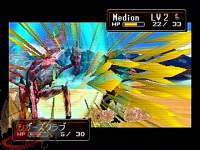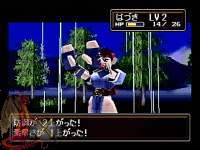|
|

|
BATTLE SYSTEM
|

|
INTERACTION
|

|
ORIGINALITY
|

|
STORY
|

|
MUSIC & SOUND
|

|
VISUALS
|

|
CHALLENGE
|
Satisfying
|
COMPLETION TIME
|
30-40 hours
|
|
OVERALL
5.0/5
|
Rating definitions
|
|
|
Before the English version of Shining Force III Scenario 1 was released, Shining Force III Scenario 2 was released in Japan. This factoid is intended primarily to continue hammering away at Sega of America’s stupidity in releasing only Scenario 1 outside of Japan. To anyone who has played Scenario 1, Scenario 2 is a mandatory play. Without that background Shining Force III Scenario 2 is still a superb title, but not the greatness it becomes when enmeshed with 1 and 3.
Shining Force III Scenario 2 does not suffer from the ‘middle child’ syndrome of many trilogies, because Shining Force III is not a trilogy in any conventional sense. Scenario 2 does not take place after Scenario 1 but instead concurrently with it. Scenario 2 begins in the same city Scenario 1 does, under the same cloud of Imperial/Republican negotiations to avoid war. Prince Medion, third son of Emperor Domaric, is pondering matters large and small on a Saraband dock when the smell of gunpowder alerts him and his entourage. Masked Monks of Bulzome take issue at having their gunpowder scented, and after a fight they withdraw. Seeking their modus operandi, Medion pursues only to run into the reason for the gunpowder’s presence; explosions all over Saraband as cover for the abduction of Emperor Domaric. Medion is promptly drawn into the gigantic war erupting as Imperial commanders are dispatched to fight the Republic wherever able, Medion’s main army along with them.
 Crab fishing takes a deadly turn this year….
Crab fishing takes a deadly turn this year….
|
|
Medion and his core Shining Force, however, are suspicious of what is going on, and determine to track down King Benetram to learn the truth. Searching out Synbios and Benetram is the first task for Medion to accomplish, and once they have finally met Medion determines that the sea power of Imperial General Rogan must be enlisted to rescue his father from the Bulzome, which means he must set off toward Barrand. Enroute he meets with Synbios again and learns of the need to investigate the holy land of Elbesem, which is receiving great attention from the Bulzome.
Battles in Scenario 2 are the same as in Scenario 1, which simultaneously makes perfect sense and will aid one who cannot read Japanese. There are differences, of course: every battle in Scenario 2 is on a different battleground than in Scenario 1 (save one early battle, and even it has a completely different enemy roster and goal). One nice addition is that when ‘B’ is pressed in battle the Boss of the battle will be clearly delineated by a red icon, where in Scenario 1 moving through the enemy ranks until the Boss was located proved necessary. Also using the L and R buttons will scroll quickly through the ranks of the Shining Force’s statuses now, where it was rather less speedy in Scenario 1.
These improvements are handy, but the battle system was already elegant in its simplicity. Shining Force battles are overhead turn-based affairs with up to 12 player-controlled characters facing off against a larger number of enemies. 100 experience to go up a level, experience gained mostly by combating enemies, promotion available at level 10 – this was all stated regarding Scenario 1 and still holds true. Same for weapons being more effective against certain opponents, special attacks of weapons, magic levels, and summons. Medion is the leader this time around, although keeping him from falling in battle isn’t hard since he’s hardly weak.
 Hazuki is notoriously camera-shy. At least she didn’t attack the paparazzi today.
Hazuki is notoriously camera-shy. At least she didn’t attack the paparazzi today.
|
|
One fun addition to the battles (this applies in Scenario 1 also) is the Ruins. If the player can locate a Ruins Map, there is one battle per Chapter (six Chapters to a Scenario) in which it is highly useful. With a Ruins Map the player can enter some Ruins during battle, and inside those Ruins are highly desirable items. Without the Ruins Map the player cannot enter. There is a catch, however: upon a character’s inspection of the Ruins at least one Thief will also enter. These Thieves have higher agility than anyone else and want the treasures of the Ruins for themselves. But they are also the only beings able to open certain treasure chests, and if they all die the Ruins collapse. Also characters dispatched into the Ruins need a turn to recuperate both from entering and from leaving, stretching battle time out a fair amount.
The Friendship system also applies throughout the Scenarios and has not been discussed yet. When an enemy is struck, the next character to strike that enemy garners Friendship points with the first character. This keeps applying, so that the next character to strike after the second striker will gain Friendship points with the second. With a few Friendship experiences a Partner status will be achieved, and this goes up to Friend, Trusted and Soulmate (or Love Love in the Japanese). Friendships kick in when a character is standing directly adjacent to the companion, or in the case of a Soulmate from two spaces away. The exact benefits of Friendship depend upon the character: Syntesis raises Magic potency, Rock raises Defense, David raises Attack. The benefits rise with the increase in Friendship levels, and letting a character fall in battle drops all of his/her Friendships one level. Preventing this from happening is a good idea.
One other item that changed from earlier Shining Force titles is the introduction of magic resistance for the characters. Mages in particular are somewhat less vulnerable to magic than physical attacks, for good reason. Each character has a level of resistance to all six elements displayed, and it can be raised considerably by the Resistance spell along with certain weapons and accessories.
Medion’s team gets a few new classes of characters to play around with, in addition to most of the classes Synbios’s team had making a return in some form. David is interesting: as a Ranger he commands use of knives, hand axes and spears, but cannot use any close-range-only weapons. His girlfriend Hedoba, presuming the player can keep from killing her, is a Summoner. She has Freeze magic along with the ability to summon Wendigo and Zephyrus. Arthur is a Magic Knight, and while his attack isn’t too great for a centaur he commands Blaze, Freeze and Spark magic. Pappesh is a Tamer, with the ability to recruit monsters he kills: he is also the only character in the entire Shining Force III experience to use whips as his weapons.
The challenge of Scenario 2 is probably the lowest overall of the Scenarios, but that does not mean it is without adrenaline-pumping moments. Chapter 4 in particular has some nasty moments. Again, merely making it through the game is far less challenging than gaining all the hidden characters and items/weapons. The completion time for Scenario 2 is about the same as Scenario 1, which makes sense when they are occurring concurrently.
Interaction is again a non-issue. Shining Force III’s battle menus are icon-based, making the lack of English less great an issue. Attack, Magic, Item, and Defend are the options in battle. Item can be used to change the equipped weapon in battle, a very useful and often-utilized feature. Magic takes the player to the usable magic of a character, from which the level it will be used at shall be decided. And targeting is intuitive and automatic, with the player able to pick between all potential targets until the right one is found. Outside of battle there is a lot of Japanese text to sift through in the form of the story, but the translations available here - http://www.shiningforcecentral.com/scripts.php?m=0&g=11 - ought to make that less aggravating than needing to figure out what is going on based on context alone (I tried it, didn’t work very well).
Visually Scenario 2 looks exactly the same as 1 outside of the battle animations. Since Scenario 1 already looked great that way, 2 does also. The battle animations look quite a bit better in Scenario 2 however, and there are plenty of additional spells to look at the effects of along with new enemies to observe. Also new special attacks and summons to see. The music features all of the tunes from Scenario 1, along with some new ones that are very cool to listen to. Motoi Sakuraba turned out a superb score for this one…. And the voice acting in Scenario 2 features none of the issues that afflicted Scenario 1, as Camelot did NOT recruit the inmates from a lobotomy-patient ward to do it. Voice acting, incidentally, takes place only during the battle cut-scenes.
Shining Force III Scenario 2 is a superb title in its own right, but by itself is not nearly as great as when taken together with the rest of the game. Understanding the Imperial side of the story is incredibly important, as otherwise the rest of the game possesses sizable holes in the story. And few of the battles in Scenario 2 are unmemorable. But this is merely a part of the overarching Shining Force III tale, and if judged on its own would be slightly lesser for it. Shining Force III is meant to be judged as a whole, however, and that is how I judge it.
Review Archives
|









